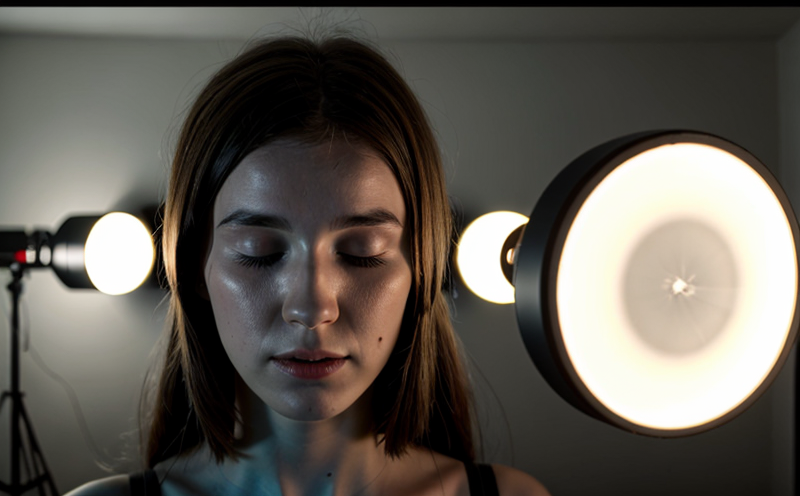ISO 21118 Flicker Testing of Projector Light Sources
The ISO 21118 standard specifies procedures to determine whether a light source exhibits flicker, which can be harmful or annoying for users. This is particularly important in the context of projectors where flicker can lead to eye strain and discomfort, especially during prolonged viewing.
Projector technology has advanced significantly over the years, with various types such as digital light processing (DLP), liquid crystal on silicon (LCoS), and laser lighting systems. Each type may exhibit different levels of flicker depending on the design and operation. Flicker is typically caused by the modulation of the light output at a specific frequency that can be perceived by human vision.
The ISO 21118 standard defines flicker as an oscillation in the luminance of a light source, which may cause visual discomfort or annoyance. The test method outlined in this standard is designed to identify whether projectors meet specified limits for flicker, ensuring that they are suitable for use in environments where prolonged viewing is required.
The testing process involves measuring the luminous flux and instantaneous luminance of the light source over time. This data is then analyzed using specific algorithms provided by ISO 21118 to determine if flicker exceeds acceptable limits. Compliance with this standard ensures that projectors are free from excessive flicker, which can enhance user experience and meet regulatory requirements.
For accurate testing, the specimen preparation involves ensuring the projector is in a stable operating condition before testing begins. This includes calibrating the projector to its optimal settings and performing any necessary adjustments to ensure consistent performance throughout the test.
The instrumentation used for this testing typically includes photometers and spectroradiometers capable of measuring luminous flux and instantaneous luminance with high precision. These instruments are crucial for capturing detailed data that can be analyzed according to ISO 21118 criteria.
Reporting involves documenting the results of the flicker tests, including any deviations from acceptable limits. This report is essential for quality control purposes and compliance with regulatory standards. The report should also include recommendations for addressing any issues identified during testing.
Quality and Reliability Assurance
- Consistency: Ensuring consistent performance across all projectors by adhering to ISO 21118 standards.
- Precision: Utilizing high-precision instrumentation for accurate measurement of flicker levels.
- Accuracy: Adhering to the strict criteria outlined in ISO 21118 to ensure reliable testing results.
- Compliance: Meeting regulatory requirements and ensuring compliance with industry standards.
By adhering to these principles, laboratories can provide clients with accurate, reliable, and consistent test results. This not only enhances the quality of their products but also builds trust among stakeholders, including consumers, regulatory bodies, and partners in the lighting sector.
International Acceptance and Recognition
The ISO 21118 standard has gained widespread acceptance across various countries due to its rigorous testing methodology. Many countries have adopted this standard as a means of ensuring consumer safety and enhancing product quality. For instance, in Europe, the standard is recognized by bodies such as CEN (European Committee for Standardization) and EN (European Norms), which often incorporate ISO standards into their own regulatory frameworks.
The United States also recognizes ISO 21118 through its national standards body, ANSI (American National Standards Institute). Similarly, organizations like IEC (International Electrotechnical Commission) have endorsed this standard for use in global markets. This international recognition ensures that products tested according to ISO 21118 are accepted worldwide.
The adoption of this standard by major lighting manufacturers and retailers further reinforces its importance. By ensuring compliance with ISO 21118, these companies can demonstrate their commitment to producing high-quality projectors free from flicker, thereby enhancing brand reputation and customer satisfaction.
Competitive Advantage and Market Impact
Compliance with ISO 21118 provides significant competitive advantages for manufacturers of projector light sources. By ensuring that their products meet the strictest standards in terms of flicker, they can differentiate themselves from competitors who may not adhere to such rigorous testing protocols.
The demand for flicker-free projectors is increasing as consumers become more aware of its potential impacts on visual comfort and health. Manufacturers who comply with ISO 21118 are better positioned to meet this growing market need, thereby attracting a wider customer base. This can lead to increased market share and higher sales volumes.
Moreover, compliance with international standards such as ISO 21118 enhances the credibility of manufacturers in the eyes of regulatory bodies and industry partners. This can facilitate easier market entry into countries that have stringent standards for consumer products. It also allows companies to participate more effectively in global trade negotiations and partnerships.
In conclusion, adherence to ISO 21118 not only ensures product quality but also provides a strong foundation for achieving competitive success in the lighting sector. By investing in this standard, manufacturers can build trust with consumers, regulatory bodies, and partners, ultimately driving market growth and innovation.





